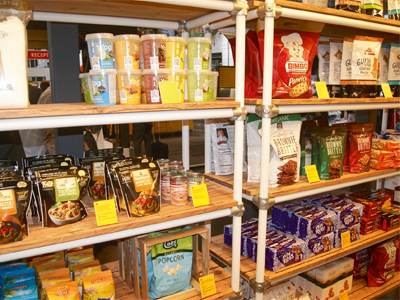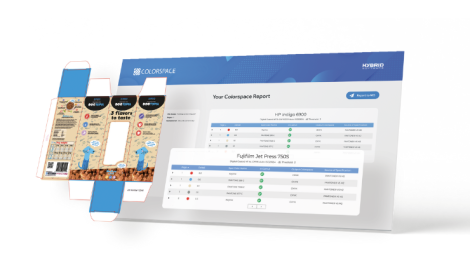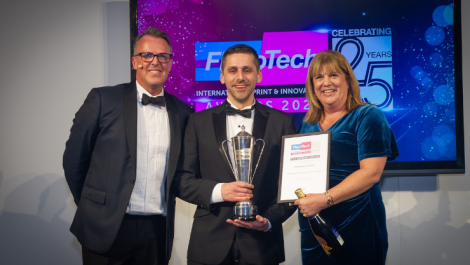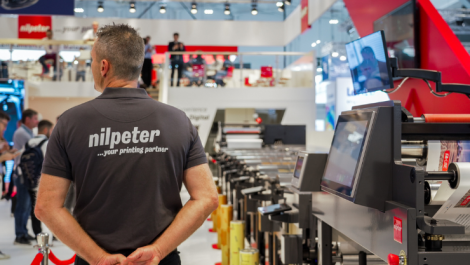The Kodak store showed products printed using Kodak technology
As a technology flexo may well be outnumbered by the technologies serving the commercial market, but due to the vastness of drupa there was still plenty of flexo at the show and a lot of it was inventive and progressive with a touch of the future about them. Michal Lodej reports.
Speaking to suppliers to the flexo industry at drupa a common theme appeared very quickly, which was to future proof the flexo production. Many suppliers were aiming towards automation of job set-ups and developing a workflow driven by real time information not only streamline a print operation but to create a smart operation. The craft of flexo printing is becoming more sophisticated, controlled and scientific.
Press to advance
If any press had a futuristic vibe, it was Comexi’s new F1 wide web press, which automates sleeve changes with a robotic arm. This eliminates the problems with manually lifting large sleeves. The robot is built by the Japanese manufacturer Fanuc and can change sleeves with repeat lengths of up to 1250 mm. The F1 can print in 8 and 10 colours with formats of between 450 and 1350 mm, material widths up to 1720 mm and a velocity of 600 m/minute.
KBA FlexoTechnica launched the new Neo XD LRcentral cylinder press, which according to the company was the only flexo press at drupa to print with water based inks onto plastic film.
The press is a flexo hybrid, not like those which bolt on an inkjet head one which can use different flexo inks such as solvent, water-based, UV-LED or EB inks, either as single printing process, or as a multi-process combination; on the main central drum printing group as well as on inline units. This allows a wide range of different applications to be printed on the press.
The press can run with up to twelve colours with a cut-off from 400 to 1200 mm, a maximum web width of 1650 mm and a maximum printing speed of up to 500 m/min.
In the live demonstration at the show an eight colour sleeve change was made in about five minutes, this was achieved, however, with two operators, one to change the rolls while the other moved the ladder into place.
Uteco showed its new Onyx X5 Eco One. This new machine runs with a web width of 600-1000 mm and can run at up to 300 m/min. It is a flexo press developed to run with EB inks. With this technology, printing, coating/laminating and curing are all done inline in one pass. The press is able to print wet on wet, add a laminate or coating and then all be cured after. This speeds up production times considerably.
Focus Label Machinery came to drupa with some new additions and modifications to its range of equipment for narrow web printing & converting. The Proflex model now is now equipped with easy load print cylinders, allowing the operator to load the print cylinders into the print station from above, reducing job changeover time. The Proflex is available with servo drive (Proflex SE) or mechanical drive (Proflex e) with web widths of 250 mm and 330 mm.
Visitors were also able to see the full servo eFlex model with pre-register and auto register provided as standard. The eFlex is a highly automated model, with web widths of 330 mm and 430 mm
Also creating a lot of interest was the dFlex, digital inkjet-flexo hybrid press for short to medium run lengths, with variable data facility, for web widths of 250 mm and 330 mm. In addition, Focus showed the latest version of their high speed FS330 inspection rewinder with integrated rotary die station.
Soma introduced the Optima II press which is an upgrade of the original Optima press with the aim to make start up times faster, reduce wastage and to reduce plate bounce. To reduce set up times the company partnered up with German press manufacturer Allstein to integrate the Arun plate mounting system into the Optima II. This system mounts the next job whilst also calculating impression and register settings as the press is running. The mounting system is also crucial to the press’ waste saving function.
During mounting the impression and registration settings are stored in a microchip in the sleeve. This information is then later read by the press to fully automate the registration and impression setting. However, this requires a special type of sleeve, which can be purchased from PolyWest, Flint Rotec and Rossini. The company said tests have shown that waste can be reduced to 5 metres, the circumference of the central impression drum.
The final problem for Soma to solve was plate bounce. This has been dealt with by the way the press is constructed. The press uses a single block printing unit frame, which provides rigidity to the press.
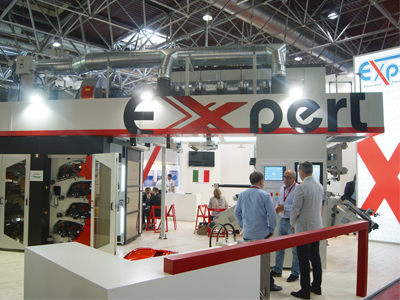
Expert’s Compact press has a print width of 600-1000 mm
Expert was also showing a CI press, which according to the company was the most compact CI press in the whole exhibition measuring in at 8.36 m long, 4.3 m high and 3.92 m wide (including the ink buckets) for an eight colour press. The aptly named Compact is developed for short runs with a web width ranging between 600 and 1000 mm. The machine’s print repeat ranges from 240 to 650 mm and it can run at up to 300 m/min.
Although CI press’ are not the usual choice for a label printer the press has caught the interest of some label printers who are drawn in by its small footprint.
Knowledge is power
As important as upgrading hardware is, too many flexo printers are not recording any data or information about how that hardware performs. To improve this Comexi also launched a new cloud based software, Comexi Cloud, which allows press owners to monitor and control the performance and productions of the presses in the factory from anywhere in the world via laptop or tablet.
The system saves data from each job, users can see every aspect of every print run to determine what is working well and what is not. It can accurately calculate and analyse all aspects of the print run including down time.
An added bonus to this workflow monitoring system is that is also allows the user to generate jobs remotely too. With just a few clicks an order can be created with some minor alterations to the art work available.
QuadTech launched new software management devices for the packaging sector, ColorTack with InkControl. The software integrates with ink formulation software to simplify workflow, and reduce the number of ink corrections needed to achieve the correct colour.
Colour specifications are imported into ColorTrack’s Job Setup, and the data is immediately accessible to the ink kitchen and the pressroom. After a proof is run, a first round of colour checks is performed by ColorTrack software. Measurements can be obtained with traditional handheld instruments, or on-the-fly with the company’s inline Color Measurement System.
The exact recipe correction is calculated automatically, and proprietary virtual scales accurately determine the amount of ink remaining in each print unit-without additional hardware installation. The company focused on the software being user friendly, and so when ink is being added, a bar on the screen appears which fills up as the operator pours in the ink. This means the operator does not have to think about weights or measurements, but simply follows the visual display and stops pouring when the bar is full. The data is saved and allows users to go back and check what corrections have been made for any job.
The software can get colour references from a range of media types. This could be in the form of data files, color books, digital formulation guides, ink samples, or even printed product samples. It works with XRite information to calculate recipes. It can calculate overprints and calculates the inks consistency which is important to make accurate alterations.
It also knows if there are any similar recipes to reuse and if any recipes have the same targets. It will know if two colours are the same even if they have different names, so for instance a job needing Ferrari red could use Marlborough red instead if it is already in stock.
The company also released a new version of DeltaCam. This version of the inline spectral 100% inspection system is designed specifically for the packaging market and is half the price of the original as the company tries to open up colour management to smaller print companies.
DeltaCam is capable of performing at speeds of up to 610 m/min and on web widths up to 2200 mm, reading a single 5 mm x 5 mm colour patch. The imager reads the spectral response of colour mark patterns or other defined locations in the image, and the system’s software calculates L*a*b* and density values-then calculates the ∆E and ∆D from the target.
Automation off the press
Increasing uptime can be achieved off the press y streamlining the job preparation routine. Beissse also had a product to reduce change over times and although it was not at the show to see. The company launched the TPMM tape and plate mounting machine to automate the plate and tape mounting process. The mounter comes with features to check the tolerances of the sleeve and automatic cutting for tap application, to prevent operators cutting on the sleeve which can often damage the sleeves. It can mount 50 sleeves in a six hour shift helping to increase production.
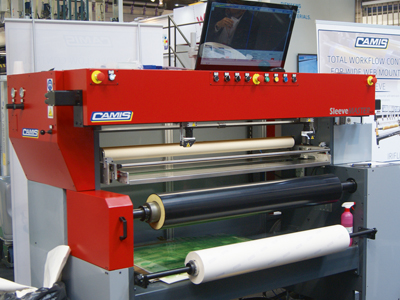
Eurograv demonstrated the Camis SleeveMaster HD
For those who did want to see a mounting machine in action, Eurograv was demonstrating the latest Camis product, the SleeveMaster HD. The mounter uses both camera and mandrel positioning, both of which are controlled by a CN unit programmable by a touch screen that allows the operator to save jobs for a quicker set up in following orders.
The cameras move on linear guide ways, fitted to a support beam. The mandrel is fitted with in the slide frame to ensure stability and is equipped with adaptors to ensure it is compatible with all sleeves, which can be changed with a semi-automatic sleeve change system.
The image capture system is made up of two digital cameras with an accurate focus system that identifies any anomalies on the plate. The SleeveMaster HD features new control and check facilities to help the operator set the plates in register and a high end HD graphics package to meet the advancements made in high resolution HD plates.
The company registered a lot of interest in its machines at drupa and notable sales included a six camera unit sold to a company in Russia and a four camera Irisleeve unit, with full width power tape application, sold to a UK company and Total Work Flow Control Irisleeves sold into Brazil and Poland.
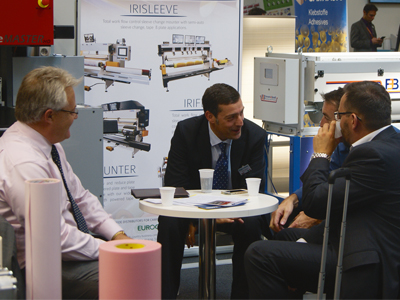
drupa was the scene of many deals
Advancements and updates
Kodak announced an addition to the NX plate platform, NX 16 to customers at drupa. The plate system uses Advanced Edge Definition, which creates much smaller dots at the edge of each object to control the ink and the air flow across the plate.
This feature enables the System ’16 to serve a wide range of applications, including wide web flexibles, narrow web labels, paperboard printing and corrugated post-print, with a single plate type. This gives pre-press operations an operation to switch from competitive technologies.
At the show Kodak reached the milestone of the 500th sale of its NX plate system, which was bought by Multidruk, a Polish flexographic prepress provider that is expanding its services to the rest of Europe. The new Flexcel NX Wide System will be an addition to the mid-sized device they ordered in 2012.
Christopher Payne, Kodak’s general manager and vice president flexographic packaging solutions toldFlexoTech, ‘The company has focused much of its R&D efforts into how ink and air flows over the plate as we know that this affects the print and also efficiencies elsewhere in the press room. We’re also focused on how we change the industry in ecological and sustainability terms and want to change all the parts of the industry that use toxic chemicals.’
The company is hoping that its next product release will help to achieve its eco friendly aims. Kodak spoke of a plate technology which was not yet ready for public release but was being shown to selected customers, Ultra NX. This yet to be release technology is supposedly meant to improve a printer’s eco friendly credentials.
Zecher had a different approach at drupa 2016 with a new programme of anilox engraving arrangements to put the print room into a clear structure. This consisted of identifying and organising aniloxes into different volumes, each volume with a specific application.
The company showed its stepped hex anilox engraving, which is a combination of three different engravings based on the 60 degree shaped cell which it said can increase the line count but with the same volume of ink.
Jörg Rohde, head of applications engineering, Zecher, said, ‘Open cell engravings are good for ink flow but need to be run at faster speeds, which affect other parts of the press’ performance. This engraving system allows the printer to reduce speeds. These cells are staggered to improve print resolution as it reduces vibrations from the doctor blade. It also increases the amount of applications which can be printed with the same anilox. This helps operators improve on downtimes as a change of anilox is required less often.’
Martin Automatic’s stand showed what the company offers to the diverse markets it supplies to. For a flexo printer its range of slitting rewinding options would be on interest as well as its slitting closet. In the closet visitors could see a wide range of different materials which have been slit and rejoined using different techniques.
A highlight of the stand was the company’s newest technology for its idler rollers. Visitors were able to experience the weight differences of three idler shells, each three metres long. The Airnertia and MDR roller demo allowed visitors to see the practical effects of roller mass on rotational inertia. Airnertia is the company’s patented roller technology that uses a near frictionless air bearing system to minimise roller inertia. Magnetic Driven Roller (MDR) technology actively accelerates or decelerates idlers rollers as the process dictates, to greatly reduce or even eliminate the impact of idler roller inertia and bearing friction. This patented material was extremely light whilst offering the industry standard for stiffness.
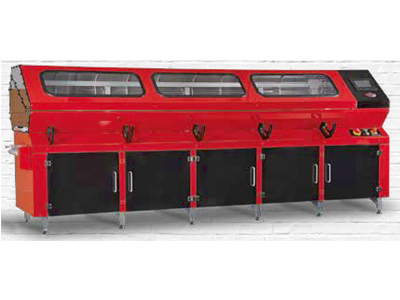
Flexomaid A5 wide web cleaning unit with air stream technology
Flexomaid made additions to its Areomaid range with middle and wide web cleaning units, the A3, A4 and the A5, with cleaning lengths of 1346 mm, 1956 mm and 2565 mm respectively.
Just like the other models in the Flexomaid range these units use air stream technology to provide efficient, non-abrasive and contact-free cleaning that is safe for the roller.
Equipped with an advanced laser sensor, the cleaning unit’s powerhead detects the roll’s characteristics such as diameter, length and surface to optimise the rotation speed and powerhead movement pattern to provide consistent deep cleaning for any roll format.
Once these characteristics have been calculated, the unit uses the minimal quantity of detergent and rinsing agent to ensure optimal cleaning results with the least amount of waste. In fact there is no liquid waste to dispose of as an absorbent paper mat beneath the roll collects the few drops of wet residue. A specially-designed conveyor automatically displaces the paper mat a few millimeters after every cleaning cycle.
The cleaning systems can use three premium biodegradable detergents, water-based inks, UV-based inks and solvent based inks, and an aqueous based rinsing agent.
Exhibitions within exhibitions
While the next drupa is not for another four years there will be other chances for you to wear yourself out whilst perusing the best offerings of the printing industry, such as the Print4All exhibition which was announced at drupa to take place in 2018.
Print4All is the result of the collaboration between associations ACIMGA (Italian Manufacturers’ Association of Machinery for the Graphic, Converting and Paper Industry) and Argi (the Graphic Industry Suppliers Association), and combines three long-standing brands showcasing specific industrial production chains with strong synergies between the respective target markets: Converflex, Grafitalia and Inprinting.
The trade shows will be linked together so that customers can see the entire supply chain and will be held in Milan, in 2018, and with over 18 halls and an anticipated 150,000 visitors.
The trade fair will show a wide mixture of technologies to reflect that many printers cannot be simply split between digital and conventional. Instead printers usually have a mixture of technologies and will need to see them all in one place.
This Print4All exhibitors will have the chance to present technology applicable across all of the production chains involved in the exhibition project. Visitors will get a comprehensive overview, in a single show, of the technological solutions available in all segments of the industrial supply chain, with strong synergies in terms of market information, technological innovation and best practices in every sector.

